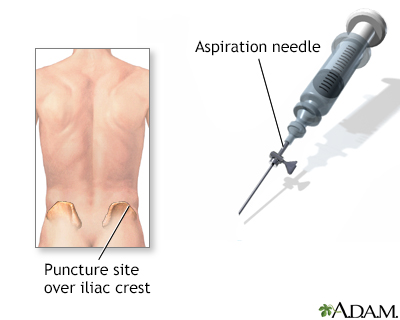Pregnancy SmartSiteTM
Biopsy - bone marrow DefinitionA bone marrow biopsy is the removal of marrow from inside one of your bones. Bone marrow is the soft tissue inside bones that helps form blood cells. It is found in the hollow part of most bones. Bone marrow biopsy is not the same as bone marrow aspiration. An aspiration removes a small amount of marrow in liquid form for examination. How the Test is PerformedA bone marrow biopsy may be done in your health care provider's office or in a hospital. The sample may be taken from the pelvic or breast bone. Sometimes, another area is used. Marrow is removed in the following steps:
A bone marrow aspiration may also be done, usually before the biopsy is taken. After the skin is numbed, the needle is inserted into the bone, and a syringe is used to withdraw the liquid bone marrow. If this is done, the needle will be removed and repositioned. Or, another needle may be used for the biopsy. How to Prepare for the TestTell your provider:
How the Test will FeelYou will feel a sharp sting when the numbing medicine is injected. The biopsy needle may also cause a brief, usually dull, pain. Since the inside of the bone cannot be numbed, this test may cause some discomfort. If a bone marrow aspiration is also done, you may feel a brief, sharp pain as the bone marrow liquid is removed. Why the Test is PerformedYour provider may order this test if you have abnormal types or numbers of red or white blood cells or platelets on a complete blood count (CBC). This test is used to diagnose: It may also be used to help determine if a cancer has spread or responded to treatment. Normal ResultsA normal result means the bone marrow contains the proper number and types of blood-forming (hematopoietic) cells, fat cells, and connective tissues. What Abnormal Results MeanAbnormal results may be due to cancers of the bone marrow (leukemia, lymphoma, multiple myeloma, or other cancers). The results may detect the cause of anemia (too few red blood cells), abnormal white blood cells, or thrombocytopenia (too few platelets). Specific conditions for which the test may be performed:
RisksThere may be some bleeding at the puncture site. More serious risks, such as serious bleeding or infection, are very rare. ReferencesBates I, Burthem J. Bone marrow biopsy. In: Bain BJ, Bates I, Laffan MA, eds. Dacie and Lewis Practical Haematology. 12th ed. Philadelphia, PA: Elsevier; 2017:chap 7. Chernecky CC, Berger BJ. Bone marrow aspiration analysis-specimen (biopsy, bone marrow iron stain, iron stain, bone marrow). In: Chernecky CC, Berger BJ, eds. Laboratory Tests and Diagnostic Procedures. 6th ed. St Louis, MO: Elsevier Saunders; 2013:241-244. Choby BA. Bone marrow aspiration and biopsy. In: Fowler GC, ed. Pfenninger and Fowler's Procedures for Primary Care. 4th ed. Philadelphia, PA: Elsevier; 2020:chap 220. Vajpayee N, Graham SS, Bem S. Basic examination of blood and bone marrow. In: McPherson RA, Pincus MR, eds. Henry's Clinical Diagnosis and Management by Laboratory Methods. 24th ed. Philadelphia, PA: Elsevier; 2022:chap 31. | ||
| ||
Review Date: 6/17/2024 Reviewed By: Todd Gersten, MD, Hematology/Oncology, Florida Cancer Specialists & Research Institute, Wellington, FL. Review provided by VeriMed Healthcare Network. Also reviewed by David C. Dugdale, MD, Medical Director, Brenda Conaway, Editorial Director, and the A.D.A.M. Editorial team. View References The information provided herein should not be used during any medical emergency or for the diagnosis or treatment of any medical condition. A licensed medical professional should be consulted for diagnosis and treatment of any and all medical conditions. Links to other sites are provided for information only -- they do not constitute endorsements of those other sites. No warranty of any kind, either expressed or implied, is made as to the accuracy, reliability, timeliness, or correctness of any translations made by a third-party service of the information provided herein into any other language. © 1997- A.D.A.M., a business unit of Ebix, Inc. Any duplication or distribution of the information contained herein is strictly prohibited. | ||


 Bone marrow aspira...
Bone marrow aspira... Bone biopsy
Bone biopsy
